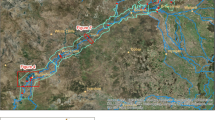Abstract
A cell-based distributed watershed model is developed which enables us to simulate the hydrological and hydraulic aspects of the watershed in a refined fashion. With three-zoned cell profiling, the model is composed of three sub-models; tank model for a surface water zone, soil moisture model for a surface soil zone, and unconfined shallow groundwater flow model for a subsurface zone. Inclusion of the soil moisture sub-model modified to reroute the infiltration, routed from the tank sub-model, into the return flow and the groundwater recharge features the model. The groundwater flow sub-model, numerically approximated by use of the finite volume method and the implicit time-marching scheme, considers a network of on-farm drainage canals as internal boundaries, which is an essential need for modeling the watershed including farmlands. Cascade-linking of the three sub-models in a cell and assembling of all the cells over the entire watershed domain provides the global equations system to be solved. Applicability of the model is demonstrated with its practical application to a real watershed in that paddy and upland crop fields take great part of the land-use practice. It is then indicated in a quantified manner that rice farming significantly contribute as a major groundwater recharger in an irrigation period to fostering and conservation of regional water resources. Along with appropriately profiling a cell, the model is so versatile and tough that it can be applied without difficulty to a watershed of diverse terrains and land-uses and the computations can stably be carried out. It is thus concluded that the model presently developed could be a powerful “watershed simulator” to investigate and assess the time-varying hydro-environmental properties of a watershed while separating and integrating the hydrological and hydraulic components of particular importance.















Similar content being viewed by others
References
Alam AHMB, Takeuchi J, Kawachi T (2006) Development of distributed rainfall-runoff model incorporating soil moisture model. Trans JSIDRE 244:29–37
Alam AHMB, Takeuchi J, Kawachi T (2007) GA-designed fuzzy rule-based system for parameter estimation of distributed rainfall-runoff model considering various cell characteristics. J Rainwater Catchment Syst 12(2):29–37
Anan M, Yuge K, Nakano Y, Saptomo S, Haraguchi T (2007) Quantification of the effect of rice paddy area changes on recharging groundwater. Paddy Water Environ 5:41–47
Brath A, Montanari A, Toth E (2004) Analysis of the effects of different scenarios of historical data availability on the calibration of a spatially-distributed hydrological model. J Hydrol 291:232–253
Domenico PA, Mifflin MD (1965) Water from low peameability sediments and land subsidence. Water Resour Res 1(4):563–576
Editorial Board of Imazu History (2003) History of Imazu, vol 3. Local Government, Imazu Town, 467 pp (in Japanese)
Elhassan AM, Goto A, Mizutani M (2001) Combining a tank model with a groundwater model for simulation regional groundwater flow in an alluvial fan. Trans JSIDRE 215:21–29
Helmig R (1997) Multiphase flow and transport processes in the subsurface. Springer-Verlag, Berlin, 367 pp
Japan Society of Hydrology and Water Resources (1997) Handbook of hydrology and water resources. Asakura, Tokyo, 636 pp (in Japanese)
Kachroo RK (1992) River flow forecasting. Part 5. Applications of a conceptual model. J Hydrol 133:141–178
Lake Biwa Research Institute (1988) Moving atlas—Shiga prefecture regional environment atlas with data floppy disk, 83 pp (in Japanese)
Linsley RK, Kohler MA, Pauthus JLH (1958) Hydrology for engineers. McGraw-Hill, NY, 340 pp
Maruyama T, Igarashi W, Nishide T, Murakami Y, Yomota A, Takahashi T, Mitsuno T (1999) Irrigation and drainage. Yokendo, 281 pp (in Japanese)
Mitsuno T, Nagahori K (1987) The structure of groundwater budget around Yoshii Wier—Statistical analysis of observed groundwater level fluctuations around Yoshii Wier. Trans JSIDRE 127:27–33 (in Japanese)
Munakata Y, Shiratani E, Takahashi J, Hasebe H, Yoshinaga I, Hitomi T, Miura A (2006) Development of distributed watershed model for analyzing effects of irrigation on water quality. J Jpn Soc Water Environ 29(12):815–822 (in Japanese)
Nakae S, Yoshioka T (1998) Geology of the Kumagawa district. Geological Survey of Japan, 71 pp (in Japanese)
Nakae S, Yoshioka T, Naito K (2001) Geology of the Chikubu Shima district. Geological Survey of Japan, 71 pp (in Japanese)
Nakagiri T, Watanabe T, Horino H, Maruyama T (1998) Development of a hydrological system model in the Kino River Basin—analysis of irrigation water use by a hydrological system model (I). Trans JSIDRE 198:1–11
O’Connell PE, Nash JE, Farrell JP (1970) River flow forecasting through conceptual models. Part 2. The Brosna catchment at Ferbane. J Hydrol 10:317–329
Tan BQ, O’Connor KM (1996) Application of an empirical infiltration equation in the SMAR conceptual; model. J Hydrol 185:275–295
Task Committee on Standardization of Reference Evapotranspiration (2005) The ASCE standardized reference evapotranspiration equation. ASCE, 59 pp. http://www.kimberly.uidaho.edu/water/asceewri/ascestzdetmain2005.pdf
Author information
Authors and Affiliations
Corresponding author
Rights and permissions
About this article
Cite this article
Takeuchi, J., Kawachi, T., Unami, K. et al. A distributed hydro-environmental watershed model with three-zoned cell profiling. Paddy Water Environ 7, 33–43 (2009). https://doi.org/10.1007/s10333-008-0142-x
Received:
Revised:
Accepted:
Published:
Issue Date:
DOI: https://doi.org/10.1007/s10333-008-0142-x




